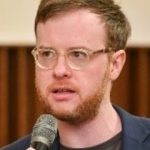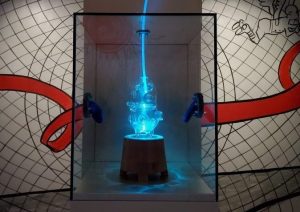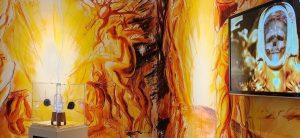A new subgroup focused on the study of posthumanities topics has been formed at BioInspired Institute. It is designed to provide space and funding for research and creative activities that push the boundaries of traditional scientific inquiry and innovation through activities and collaborations between the arts and the humanities and the science-based disciplines that have been the core of the institute’s activities.
Posthumanities is an emerging group of fields in which researchers examine the historical concepts of humans questioning those definitions and adapting them based on contemporary developments and knowledge. Where human thinking, skills and characteristics were once only able to be performed by human beings, today’s technology and scientific advancements, such as robots, artificial intelligence, genetics and bioengineering, are changing the reality of those previous interpretations.
The “Posthumanities: Arts and Sciences” subgroup joins three other areas of focus at the institute: Development and Disease, Form and Function and Smart Materials.
Leading the subgroup’s events and programming are faculty co-chairs Boryana Rossa, associate professor of art video in the College of Visual and Performing Arts, and G. Douglas Barrett, assistant professor of the television, radio and film in the Newhouse School of Public Communications.

Rossa is an interdisciplinary artist and curator working in bio-art, experimental film, video art and performance art. Her work focuses on the social implications of science and technology through a cyberfeminist (feminist approach to cyberspace, the Internet and technology) lens. A researcher and artist, Barrett teaches audio production, experimental music and media studies. His scholarship focuses on art music, experimentalism and fine arts interdisciplinary movements after World War II using musicology, art history and critical theory approaches.

James H. (Jay) Henderson, BioInspired Institute director and professor of biomedical and chemical engineering in the College of Engineering and Computer Science, says hosting a new focus area underscores the importance of recognizing how the diverse fields that are part of the University’s research and creative enterprise are interconnected. “As an interdisciplinary institute, I think we’re ideally positioned to catalyze collaborations of this kind at diverse and perhaps sometimes seemingly disparate interfaces between the University’s existing strengths, and to help lead the mission of interdisciplinary collaboration and focus on emerging technologies,” he says.
Bioinspired Associate Director Heidi Hehnly, Renée Crown Professor in the Sciences and Mathematics and associate professor of biology in the College of Arts and Sciences, has developed a Bio-Art Mixer program with Rossa as an arts, humanities and sciences collaboration. Hehnly says the new subgroup “is a visionary approach to science communication and education that amplifies the institute’s mission to address global challenges through interdisciplinary exploration and creativity. It offers exciting opportunities for innovative research projects, engaging public events and stimulating new ways of thinking about scientific concepts.”

Rossa has led art projects and programming on campus and worldwide where the arts and sciences intersect, and with Hehnly, founded the Bio Art Research Coalition of Syracuse. “The arts, sciences and technology have a common origin in trying to understand the world and communicate with it through their inventions. Historically, they have deeply influenced each other. Sharing both an intellectual and physical space facilitates easier cross-borrowing of skills and technologies,” Rossa says. “Occupying a common space with knowledge that is otherwise separated in the academic structure can also more easily spark curiosity.”
Barrett says that the fields of media studies, critical theory, philosophy, art history, ethnography and comparative literature have become increasingly relevant to the emerging practical and theoretical problems raised by advances in biology, engineering and the natural sciences. “Humans have always been the centerpiece of the humanities—language, art, music, philosophy—all sorts of areas once thought of as only human-centered endeavors. Now it seems that science and engineering more and more challenge that boundary,” he says.

The subgroup will examine the use of emerging science and technology in the fine and performing arts; the ethics and politics of biotechnology, informatics and artificial intelligence; and creative work that addresses climate change. The co-chairs are planning several spring events and exhibits, including:
- A bio-art exhibition at the Life Sciences Building representing trauma mapping by artist Aksiniya Peicheva
- A March bio-art mixer dedicated to bioinspired product design featuring the work of Yves Michel, professor of practice in industrial and interaction design in the College of Visual and Performing Arts
- Guided tours of “Assembly,” an exhibition curated by Canary Lab founders Susannah Sayler and Edward Morris, including the work, “The Mirror of Faith,” developed by Rossa and Oleg Mavromatti
- Ongoing residency projects in Hehnly’s lab, including “Glow Me Glow Me Not,” which considers genetic research within the perspective of the biological determination of human behavior
- Ongoing research and practice in intermedia art and experimental music, including Rossa’s collaborative bio-art projects and talks based on Barrett’s new book, “Experimenting the Human: Art, Music and the Contemporary Posthuman”
Rossa’s art is included in an exhibition at the Syracuse University Art Museum running through May 12. An opening reception and lecture takes place on Feb. 22.
Those interested in being an active member of the research subgroup are welcome to contact Rossa (bddragoe@syr.edu) and Barrett (dbarrett@syr.edu). The group also has an online interest survey and is developing a mailing list for routing information about programming and events.
-by Diane Stirling
